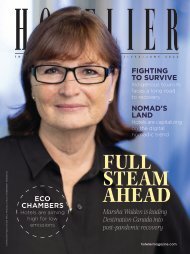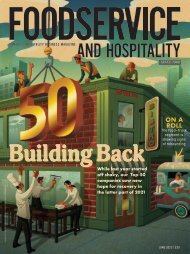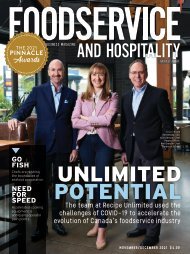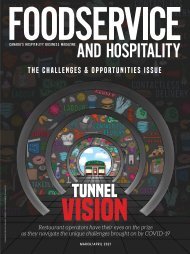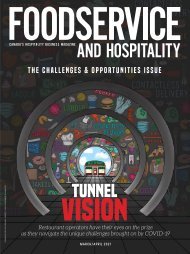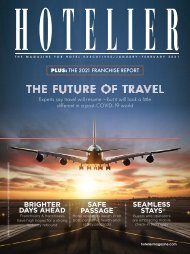FH1117
You also want an ePaper? Increase the reach of your titles
YUMPU automatically turns print PDFs into web optimized ePapers that Google loves.
FROM THE DESK OF ROBERT CARTER<br />
GLOBAL<br />
INFLUENCES<br />
Foodservice<br />
traffic grows in<br />
every global market<br />
outside of U.S.<br />
in second quarter<br />
iSTOCK.COM/PESHKOV [GLOBE]<br />
While you’ve likely heard a lot<br />
about “anemic growth” and<br />
“declining traffic counts”<br />
over the last few years, you<br />
may be surprised to hear<br />
that global foodservice traffic increased in<br />
every major market outside of the U.S. in the<br />
second quarter of 2017.<br />
This finding comes from a recent report<br />
by The NPD Group, which continually<br />
tracks consumer use of foodservice outlets<br />
in Australia, Brazil, Canada, China, France,<br />
Germany, Great Britain, Italy, Japan, Korea,<br />
Russia, Spain and the United States.<br />
Interestingly, but perhaps not surprisingly,<br />
the quick-service segment and delivery services<br />
were key drivers of global visit growth during<br />
this period as consumers globally adopted<br />
many of the same consumption habits we see<br />
in Canada.<br />
The growth of technology — and specifically<br />
mobile — has continued to change the<br />
way consumers shop for food and the way<br />
they dine out. The use of digital technology<br />
to place orders has been growing rapidly for<br />
several years, not only in Canada, but around<br />
the world. And while the “digital door” currently<br />
represents only two per cent of all<br />
foodservice and fast-moving consumer-goods<br />
orders in Canada, it continues to be a significant<br />
visit motivator, as nearly 10 per cent of<br />
consumers claim to have been influenced by<br />
a social-media platform before making a restaurant<br />
choice. In fact, in every major market<br />
The NPD Group tracks, virtually all growth<br />
in the past three years has come from mobile<br />
or internet services. Furthermore, nearly<br />
all global foodservice-traffic growth came<br />
through the quick-service restaurant (QSR)<br />
segment, where consumers have responded<br />
positively to advantageous pricing, aggressive<br />
unit expansion and advertising of QSR chains<br />
and outlets.<br />
Looking outside of North America,<br />
European markets continued solid, if unspectacular,<br />
recovery while Brazil and Russia —<br />
both mired in recession in recent years — also<br />
rebounded slightly. Even Korea posted a solid<br />
traffic gain.<br />
When looking at dayparts, visits during<br />
the breakfast dayart are growing broadly, but<br />
it’s still a relatively small daypart in terms<br />
of traffic share in most global markets and<br />
can’t drive overall growth like other meals<br />
can. Lunch traffic did increase in Brazil,<br />
China, Russia and Spain, but declined in all<br />
other countries. Visits at dinner were flat or<br />
up in most countries, with the exception of<br />
Australia, Canada and the U.S.<br />
However, perhaps the most interesting<br />
finding comes out of the U.S., where total<br />
visits to restaurants and foodservice outlets<br />
declined by one per cent — a loss of 94.5 million<br />
visits in the quarter compared to a year<br />
ago. While this finding is clearly significant to<br />
U.S. operators, it should not be overlooked by<br />
those in Canada, given that the foodservice<br />
industry is a bellwether for the economy at<br />
large and our neighbours to the south tend<br />
to have a significant impact on our economic<br />
well-being. While the U.S. has experienced<br />
seven-plus years of strong economic growth<br />
and stability, the decline in visitation traffic<br />
may indicate a slowdown in consumer confidence<br />
that may be mirrored in Canada should<br />
the nearly decade-long bull market in the U.S.<br />
come to an end.<br />
However, until that time comes, we can<br />
(and should) focus on some of the bright<br />
spots in the marketplace — after all, it’s been<br />
a while since we’ve seen such broad-based<br />
traffic growth across the globe, which makes<br />
future quarters promising. FH<br />
Robert Carter is executive<br />
director, Foodservice Canada,<br />
with the NPD Group Inc. He<br />
can be reached at robert.<br />
carter@npd.com for questions<br />
regarding the latest<br />
trends and their impact on<br />
the foodservice business.<br />
FOODSERVICEANDHOSPITALITY.COM<br />
NOVEMBER 2017 FOODSERVICE AND HOSPITALITY 15








